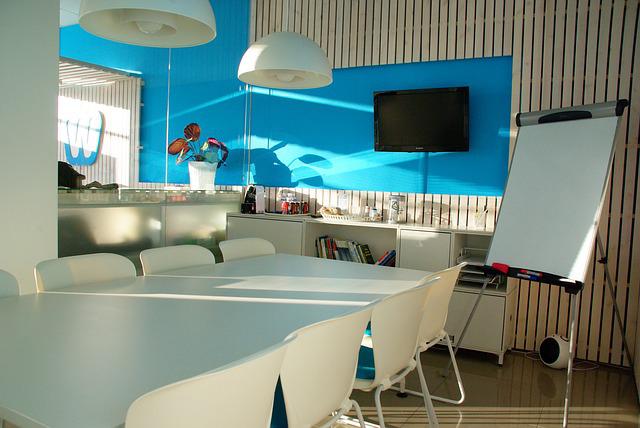The quality of lighting in your workplace can have a big impact on the productivity and performance of your employees. Poor lighting can cause eye strain, headaches, and fatigue, which can lead to decreased productivity and poor work performance.
On the other hand, good quality lighting can help increase focus, improve moods and reduce stress levels, leading to a more productive and efficient workforce. Here are 6 tips on how to use lighting to improve employee productivity:

Contents
1. Make Sure the Workplace is Well-Lit
Poorly lit workplaces can cause a decrease in productivity as employees struggle to see what they are doing. Make sure the work area is well-lit, using both natural and artificial light. Avoid glare by using diffusers or indirect lighting. When looking for lighting solutions, choose energy-efficient options to help reduce costs. For example, LED lights use less energy and last longer than traditional incandescent bulbs.
Additionally, ensure that the light levels are comfortable for employees. Too much light can be just as harmful as too little light, causing eye strain and headaches. The ideal light level is around 500 lux, or about the same amount of light as a sunny day.
2. Use Task Lighting
In addition to general lighting, use task lighting to help employees focus on specific tasks. Task lighting is a type of directed light that illuminates a specific area, such as a desk or workstation. This type of lighting can help reduce eye strain and improve productivity by making it easier for employees to see what they are doing.
For example, if your employees are working on computers, make sure they have adequate task lighting to avoid eye strain. You can also use task lighting to highlight important areas of the workplace, such as safety signage or exits.
3. Provide Natural Light
In addition to artificial lighting, provide employees with natural light whenever possible. Natural light has many benefits, including reducing eye strain, improving moods, and reducing stress levels. If possible, open windows or install skylights to let in natural light. Alternatively, use light-colored paint or wallpaper to reflect light and brighten up the workplace.
Additionally, consider using light-colored window treatments to filter sunlight and reduce glare.
Read Also:
- The Handmaid’s Tale Season 4
- Mare of Easttown Season 2
- ‘The Sinner’ Season 2
- America’s Next Top Model Winner Season 20
Window treatments are any type of fabric or material that is used to cover or decorate windows. They can be made from a variety of materials, including wood, metal, plastic, and fabric.
Light-colored window treatments are designed to reflect light and brighten up the room. This can be beneficial in workplaces, as it can help increase focus and productivity. Additionally, light-colored window treatments can help reduce glare and improve the overall appearance of the workplace.
4. Avoid Fluorescent Lighting
Fluorescent lighting is a common type of artificial lighting, but it can cause a number of problems for employees, including eye strain, headaches, and fatigue. If possible, avoid using fluorescent lighting in the workplace. If you must use it, make sure to diffuse it with indirect lighting to reduce glare.
Also, be aware that some people are sensitive to fluorescent lighting and can experience migraines or other health problems when exposed to it. If you have employees who are sensitive to fluorescent light, try to provide them with an alternative work area or allow them to use task lighting to avoid exposure.

5. Use Color Wisely
The colors in the workplace can also have an effect on employee productivity. Certain colors, such as blue and green, are known to increase focus and concentration. Other colors, such as red and yellow, can be stimulating and may help to increase energy levels.
To create a productive work environment, use colors that promote focus and concentration. For example, you may want to use blue or green for walls and yellow or red for accents. You can also use color to designate different areas of the workplace, such as using blue for offices and green for meeting rooms. Also, be sure to use colors that are pleasing to the eye and do not cause eye strain. Something like blue or green lightbulbs.
Read Also:
- Why Does Slick Rick Wear an Eyepatch
- NBA Players Who Never Made a 3 Pointer
- What Happened to Joseph From Hell’s Kitchen
Final Words
Additionally, ensure that the light levels are comfortable for employees. Too much light can be just as harmful as too little light, causing eye strain and headaches.
It is important to take into account the different ways that light can affect employees. By using quality lighting, you can help improve employee productivity and reduce costs. Additionally, be sure to use task lighting to help employees focus on specific tasks and provide natural light whenever possible.
Avoid fluorescent lighting whenever possible and use colors wisely to create a productive work environment. Keep in mind that different employees may have different needs, so be sure to cater to the individual when possible.






![Err_Connection_Reset Error in Chrome [RESOLVED] Fix Err_Connection_Reset Error in Google Chrome](https://howandwow.info/wp-content/uploads/2019/09/Fix-Err_Connection_Reset-Error-in-Google-Chrome.jpg)
![DNS_Probe_Finished_No_Internet Error [RESOLVED] Fix DNS_Probe_Finished_No_Internet Error](https://howandwow.info/wp-content/uploads/2019/09/Fix-DNS_Probe_Finished_No_Internet-Error.jpg)

![Err_Cache_Miss in Google Chrome Error [RESOLVED] Err_Cache_Miss in Google Chrome Error](https://howandwow.info/wp-content/uploads/2019/08/How-to-Fix-Confirm-Form-Resubmission-Error.jpg)





![Steam Missing File Privileges Error [RESOLVED] How to Fix Steam Missing File Privileges](https://howandwow.info/wp-content/uploads/2020/07/How-to-Fix-Steam-Missing-File-Privileges-Error-100x70.jpg)





![SIM Not Provisioned MM#2 Error [RESOLVED] SIM Not Provisioned MM#2](https://howandwow.info/wp-content/uploads/2020/03/SIM-Not-Provisioned-MM2.jpg)






